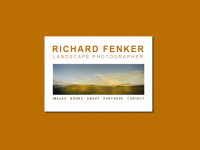Richard Fenker is a photographer and author who lives in Santa Fe, New Mexico and Fort Davis, Texas. His strongest artistic influences were Picasso, Georgia O’Keefe and Ansel Adams. Today, most of his landscape work is done in the panorama format using a Fuji 6×17 camera. His large landscapes, typically done on a fine watercolor paper or canvas, have the feeling of paintings rather than photographs — largely because of his selection of images and management of light, color and time.
“My vision of the southwestern landscape was formed in the early 1970’s as I explored — and attempted to photograph — the Big Bend area of Texas. What I experienced in person was a subtle, transcendental space, almost a boundary, between one reality and another waiting to appear at the end of the day. What I experienced on film, however, was the harsh bluntness of shapes, contrasts and colors that speak to the directness and toughness of life in a desert environment. Beginning in 1980 my experiments with black and white infrared film began to peel away a few of the outer layers, revealing some of the subtlety beneath. In the 1990’s I started to experiment with color film, attempting to create a similar effect with color prints. The dye transfer process came closest visually but still didn’t have the feeling I was seeking. After much experimentation I found that a combination of inks with a textured watercolor paper and less dramatic light throughout the scene allowed me to finally achieve the painterly results I wanted. Most of my landscapes have a soft, abstract, luminous quality that communicates the presence of the hidden layers and the feeling of a watercolor as well as a photograph.”
“For the past ten years I’ve been finding the same transcendental boundaries in natural objects such as leaves, stones, shells and butterflies and in a variety of more abstract landscapes. These represent experiments in time and space often using soft focus to create patterns with light or over time; or in the case of my stone portfolios, to find new landscapes in tiny settings.”

